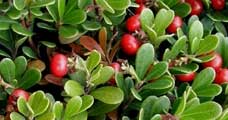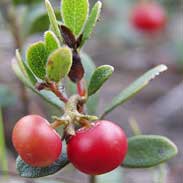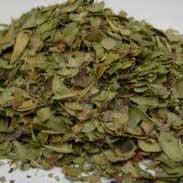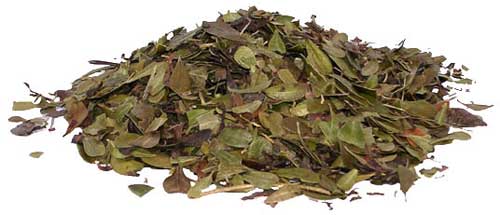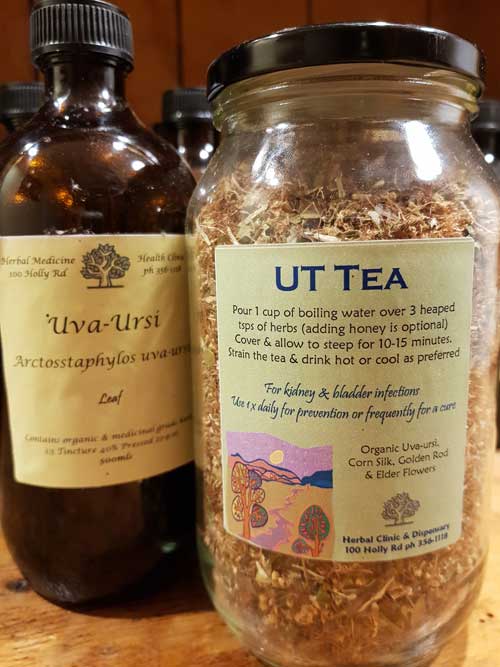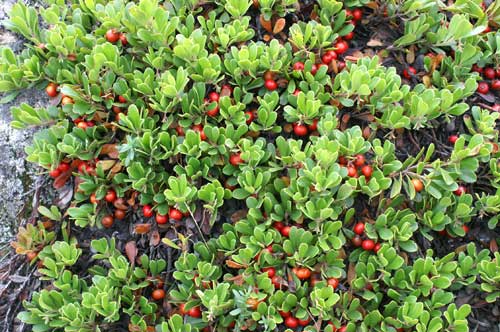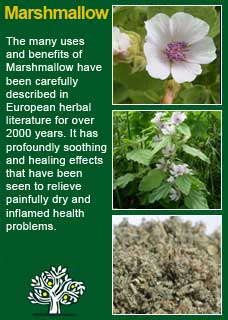
|
|
||||
| Our Pages ABOUT CONSTITUTIONAL MEDICINE
|
In herbal medicine we use the leaves of Uva-ursi which, when fresh, are small, green, shiny and oblong. Uva-ursi itself is a small evergreen shrub that grows best on dry rocky hills where it can form an extensive ground cover.
Marco Polo reported Chinese physicians using Uva-ursi to treat kidney and urinary tract problems and this served to bring it into popular use in Europe. That said there are also records of the Welsh Physicians of Myddfai already using it in the 13th century so it may already have been known about in European herbal medicine -- at least by some. Rudolph Weiss says 'Uva-ursi is indicated for treatment of all inflammatory diseases of the urinary passages especially unspecific urinary tract infections' He instructs that 'patients should be instructed to drink plenty of fluids whilst taking this herbal drug'. Uva-ursi is described by M. Grieve as 'of great value in diseases of the bladder and kidneys, strengthening and imparting tone to the urinary passages... used in inflammatory diseases of the urinary tract, urethritis, cystitis, etc. WM Cook writes 'these leaves are principally astringent, with which they combine mild tonic and soothing properties. They increase the flow of urine; and while their powers are more or less expended upon all mucous membranes, they particularly show their influence upon the urino-genital structures. In chronic and sub-acute mucous discharges–such as catarrh of the bladder, leucorrhea, gonorrhea, and gleet–they serve an admirable purpose in lessening the discharge gradually, and giving tone to the parts. We have cured several cases of lingering gonorrhea, in females, with them alone; and have found them a valuable addition to the usual tonics, in leucorrhea. So, in aching of the kidneys and bladder, congestion and ulceration of the bladder and prostate gland, involuntary seminal emissions, and incontinence of urine, they serve a good purpose. They may be used in chronic diarrhea and dysentery; and are especially suited to an ulcerated condition of the bowels in such cases–when they may advantageously be combined with hydrastis (Golden Seal) They are more gentle to the stomach than nearly any other astringent and give relief to the achings that usually accompany the above maladies' H Felter writes 'Uva Ursi is a true diuretic acting directly upon the renal epithelium. Owing to the presence of arbutin it is decidedly antiseptic and retards putrescent changes in the urine, and acts as a mild disinfectant of the urinary passages. It is to be used where the tissues are relaxed and toneless, with dragging and weighty feeling, and much mucoid or muco-bloody discharge. There is always a feeble circulation and lack of innervation when uva ursi is indicated. It is especially valuable in chronic irritation of the bladder, in vesical catarrh, strangury, and gonorrhea with bloody urination. It is claimed that when cystic calculi are present uva ursi, by blunting sensibility, enables their presence to be more comfortably borne. Pyelitis and mild renal haematuria sometimes improve under the use of uva ursi. Arbutin, in its passage through the system, yields hydroquinone, and this body, further changed by oxidation, may render the urine dark or brownish-green. This may be explained to patients taking the drug in order to allay any unnecessary fears the phenomenon may produce' King's Dispensatory writes The rapid effects of Uva-ursi depend entirely on its stimulant, astringent, and tonic powers in physiological doses, though, in the smaller doses, it will relieve chronic irritation of the bladder. In chronic affections of the kidneys and urinary passages, it is frequently useful; in vesical catarrh, chronic gonorrhoea, strangury, leucorrhoea, and excessive mucous and bloody discharges with the urine. The keynote to its use is relaxation of the urinary membranes, as is evidenced by catarrhal discharges and a feeling of weight and dragging in the loins and perineum. It undoubtedly lessens lithic acid deposits in the urine, if there are bloody and mucous discharges, and pain in the vesical region, it speedily allays all these unpleasant symptoms. Cystic spasm is relieved by it, and, when calculi are present, it obtunds the cystic membranes to such an extent that the offending material is comfortably borne. The British Herbal Pharmacopoeia (BHP) describes Uva ursi's actions as diuretic, urinary antiseptic & astringent and says it is indicated for cystitis, urethritis, dysuria (painful urination) pyelitis, lithuria (stones in the urine) and specifically indicated for acute catarrhal cystitis with dysuria & highly acidic urine. The BHP suggests a dose of 1.5-4 gms or by infusion (a heaped tsp = 2 grams) or a dose of 1.5-4mls of the ethanolic extract.
~ Uva-ursi has been extensively studied for the treatment of urinary tract infections (UTIs). UTIs are famously hard to treat for many people, they either don’t go away with antibiotics or they only go away briefly. A sugary molecule in Uva-ursi called arbutin, when it gets into the urinary tract, is transformed into ‘hydroquinone’ -- a natural, potent antibiotic (Nikolaev SM, Shantanova LN, Mondodoev AG et al? Rastitel'Nye Resursy 1996;32(3):118-123) (Robertson JA, Howard LA. J Clin Microbiol 1987;25(1):160-161) ~ In a double-blind, placebo-controlled, randomized clinical trial 57 women with recurrent cystitis were given a herbal treatment of Uva-ursi and Dandelion extract. Treatment for one month saw no episodes of bladder infections during the trial period and a significantly reduced number of recurrences for a full year following the treatment compared with placebo (Larsson B, Jonasson A, Fianu S. Curr Ther Res Clin Exp 1993;53(4):441-443) ~ Uva-ursi extracts have shown anitmicrobial activity against the common infectious organisms: Escherichia coli, Proteus vulgaris, Enterobacter aerogenes, Streptococcus fecalis, Sthaphylococcus aureus, Salmonella typhi and Candida albicans (Holopainen M, Jabodar L, Seppenene-Laakso T et al. Acta Pharm Fenn 1988;97(4):197-202) ~ The authors, titles and the 'where-and-when' published of over 40 further studies and articles on Uva-ursi are listed in a PDF found here Note that there are still occasional reports floating about in older literature about Uva-ursi being a dangerous herb that can cause vomiting, ringing in the ears, seizures etc. The source for this warning came from one study reported in 1949 which did not use Uva-ursi but rather a high dose of the isolated chemical hydroquinone, (i.e. the herb was made into a drug). This experiment does not represent how the body will respond to the whole herb.
For some years now, against this proven and safe way of herbalism, there has been a rising tide of excessive caution and scare-mongering in many parts of the world. The same authorities that, not so long ago, decried herbal medicines as ineffectual, have now taken up a different adversarial position; that they are dangerous substances that should only be prescribed by Doctors, who of course have zero training in them. Unfortunately, the same unnecessary fear and worry has crept into many natural health websites and popular publications on herbs. Herbs that we have safely used for thousands of years, that have no reports of adverse reactions in the medical literature despite widespread use by millions of people, are suddenly described as contraindicated because of something that should have been seen as completely unimportant, or at the utmost a merely theoretical concern, such as a laboratory study on one of the herb's constituents to use an all too common example. I wonder sometimes if the writers of such articles feel that the herb will be more deserving of respect if it is thought to be a little bit dangerous, in other words more like a drug than something that has simply come out of the earth and been used by ordinary people for generations beyond count. There is just so much misinformation about herbal medicine on the internet now. Ludicrous claims and cautions abound in equal measure; it seems like one group are trying to make money out of the public whilst the other are busily trying to scare them off. I have to believe that the kind of reader who takes the time to read pages on herbs that are as extensive as this one is much less likely to be swayed by marketers or misinformers. I hope that you will keep your wits about you if you get conflicting opinions from people who have never really got to know these herbs, who have never worked with them, or learned how to use them safely and effectively. I want to remind you that the reason that herbs can never be patented and owned by any individual or corporation is because they are, and always will be, the People's medicine. They belong to all of us and it is my great hope in sharing this work that you will learn how to use them wisely for yourself, and the people you care for. Be safe, but do not be afraid.
Many women with chronic, recurring cystitis have come in for treatment over the years and, whilst I always use it along with other remedies, if it so happened that there was only one thing I could use it would definitely be Uva-ursi -- I have found it to be an excellent and highly reliable herb in practice. The main active ingredient in Uva-ursi appears to be the antibiotic substance hydroquinone. It has been established that hydroquinone works best in an alkaline environment so if a urinary tract infection is not rapidly responding to Uva-ursi, then take a small half to one tsp of sodium bicarbonate (baking soda) in water at the same time as the herb to turn things around faster. The maximum benefits of Uva-ursi reach a peak at about 3 to 4 hours after taking the herb so if a urinary tract infection is severe it may be recommended to be taking a dose of Uva-ursi every 3 to 4 hours until the worst of the symptoms have resolved. You have to be careful not to exceed a certain level of the herb (maximum 2 tsps of Uva-ursi per dose, which would be approx 4 grams) or you can start upsetting the stomach but if this regime is kept up for a short while the problem should rapidly improve. My general approach is to use Uva-ursi in combination with other herbs rather than as a ‘simple’ (i.e. just by itself). For the first 48 hours I think you need to ‘flush’ the system with a lot of Uva-ursi then it is best to ease the dosage back. In practical terms this might mean using a strong tea frequently through the day for the first 2 or 3 days, up to 4 cups in a day, then dropping it back to 3, then 2, then just 1 cup a day when things have greatly improved. The tea that we nearly always give for urinary tract infections or other urinary tract conditions that might benefit from Uva-ursi is called UT tea - the recipe for it can be widely recommended and is found here
Aside from success with using Uva-ursi in acute UTIs I have also found smaller doses of it very beneficial to prevent recurrence. When you get a UTI you get some damage to the delicate smooth surfaces of the bladder and its connecting tubes (urethra and ureter) The lining of these surfaces needs to be glassy smooth to safely carry urine but the after-effects of an infection are tiny pock-mark like 'scars', on those delicate surfaces which then become ideal hiding places and breeding grounds for bacteria. A person might think they have had 6 bladder infections in the last 6 months but in fact they have just had the one infection which never properly healed from the first time. The most important goal in these cases is to prevent an infection from developing for long enough that the tissue fully heals and redevelops its smooth and unbroken surface. It takes about 6 months without any symptoms of infection for chronic cystitis to be properly 'cured'. My experience with a great many women has been that a simple cup of tea containing a tsp or so of dried Uva-ursi just once a day for those 6 months may be all that is needed to break the cycle and affect the cure. It may be equally as beneficial, and easier to maintain, to use a tincture of Uva-ursi whereby approximately 3-4mls a day will roughly equate to one strong dose of the tea. More information on cystitis is found here Uva-ursi combines perfectly with Corn Silk to open and ease the passing of the urine, with Marshmallow root to relieve inflammation and symptoms of burning, with Echinacea root to help rapidly resolve the infection and with Licorice to soften the intake of the medicine and to likewise reduce inflammation.
Much of the information here about the traditional uses of Uva-ursi is consistent with the model of thinking whereby one may treat problem A with plant B. There is value in this approach, especially in how it helps us pass on useful knowledge to one another, but it falls short in one vital area; and that is that people are not all cut from the same cloth! Something that works brilliantly for one person may do less for another -- why is this? Part of the reason is that people vary in their constitutions as to whether they are either hotter or cooler and, at the same time, either dryer or damper. This useful and rather fascinating subject is introduced further here Another big part of using the right herb when it is most needed comes from understanding the need to treat what is going wrong for the person that had led up to their getting a health condition. In this light, Uva-ursi can particularly offer its benefits when a cleansing action is needed in the 'cycle of healing', more about this here
Please understand that I cannot advise you, including on products or dosage, without seeing you in person in my clinic but for ideas
on how you might find a good herbalist in your area read here |
|
|
© 2011 R.J.Whelan Ltd
